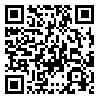1. Akbari Sari A, Vali L, Arab M, Rvangard R & Rahimi A. [Study of the relationship between nurses work environment indices and their burnout aspects in TUMS teaching hospitals]. IOHJ. 2011; 9(3): 39-51.
2. Salahian A, Asgari A, Arizi H & Baba Miri A. [Predictive factors of Burnout syndrome in Isfahan nurses.] IJNR. 2011; 6(23): 23-31.
3. Moghadassi J, Aslani Y, Etemadifar S, Masoudi R, Ravaghi K. [Nursing Burnout In Medical And Educational Centers In Shahrekord, Iran]., Jundishapur J of Chronic Disease Care. 2012; 1(1): 25-35.
4. Baker LM, O'Brien KM, Salahuddin NM. Are shelter workers burned out?: An examination of stress, social support, and coping. J Fam Violence. 2007;22(6):465-74. [
DOI:10.1007/s10896-007-9103-1]
5. Siying W, Wei Z, Zhiming W, Mianzahen W & Yajia L. Relation Between Burnout and Occupational Stress among nursing august. J Adv Nurs. 2007; 59(3): 233-39. [
DOI:10.1111/j.1365-2648.2007.04301.x] [
PMID]
6. Cieslak R, Korczynska J, Strelau J, Kaczmarek M. Burnout predictors among prison officers: The moderating effect of temperamental endurance. Personality and Individual differences. 2008;45(7):666-72. [
DOI:10.1016/j.paid.2008.07.012]
7. Aghdami AR, Najarpor S & Livarjani SH. [Relation between self-efficacy Sense and emotional intelligence with job burnout among the personnel of Islamic Azad University of Tabriz]. J of Edu Sci. 2009; 2(7): 99-119.
8. Pierkmaly MA, Momeni Mahmuei H & Pakdaman M. [The relationship between science teachers' self-efficacy and motivation, attitude and academic achievement of fifth grade students]. Res in the Curric. 2013; 10(10): 123-35.
9. Turner EA, Chandler M, Heffer RW. The influence of parenting styles, achievement motivation, and self-efficacy on academic performance in college students. J Coll Stud Dev. 2009;50(3):337-46. [
DOI:10.1353/csd.0.0073]
10. Rostami R, Shahmohamadi K, Ghaedi G, Besharat Ma, Akbari Zs, Nosratabadi M. [The Relation Among Self-Efficacy, Emotional Intelligence And Perceived Social Support In University Students]. Ofoghe Danesh. 2010; 16(3): 46-54.
11. Akbari Balootbangan A. Simple and Multiple Relationship between Self-efficacy, Achievement Goals, and Achievement Motivation in Predicting Academic Achievement among Students of Semnan University of Medical Sciences. I J of Med Edu. 2014; 14(1): 796-805.
12. Dasgupta P. Effect of role ambiguity, conflict and overload in private hospitals' nurses' burnout and mediation through self Efficacy. J Health Manag. 2012;14(4):513-34. [
DOI:10.1177/0972063412468980]
13. Aftab N, Shah A, Mehmood R. Relationship of self efficacy and burnout among physicians. Acad Res Int. 2012;2:539-48.
14. Mohammadi-Fakhar F, Rafii F, Heshmat R, Haghani H. [Relationship between Supervisor Social Support and Burnout in Nurses]. I J N. 2012;25(79):63-71.
15. Jamali Moghadam N, Soleimani S. [Burnout and its relationship with social support of nursing in hospitals of Shiraz University of Medical Sciences, 2010]. Sadra Med J. 2013; 1(2): 69-76.
16. Albarmarin M & Garcia-Ramirez M. Social support and emotional exhaustion among hospital nursing staff. The Europe J of Psychiatry. 2005; 19(2): 96-106.
17. Schwarzer R & Jerusalem M. Generalized self-efficacy scale, In S. Wright, & M. Johnston, & J. Weinman, (Eds.), Measures in Health Psychology: A User's Portfolio. Causal and Control Beliefs (pp. 35–37). Windsor, UK: nfer Nelson. 1995.
18. Momeni H, Salehi A, Seraji A. [The comparison of burnout in nurses working in clinical and educational sections of Arak University of Medical Sciences in 2008]. Arak Medical University Journal. 2010;12(4):113-23.
19. Skaalvik EM, Skaalvik S. Dimensions of teacher self-efficacy and relations with strain factors, perceived collective teacher efficacy, and teacher burnout. J Educ Psychol. 2007;99(3):611-25. [
DOI:10.1037/0022-0663.99.3.611]
20. Abolghasemi A, Javanmirry L. [The role of social desirability, mental health and self-efficacy in predicting academic achievement of female students]. 2012;1(2): 6-20.
21. Abdi Masuleh F, Kaviani H, Khaghanizadeh M, Momeni Araghi AAF. [The relationship between burnout and mental health among nurses]. TUMJ. 2007; 65(6): 75-65.
22. Hall DS. The relation between supervisor support and registered nurse outcome in nursing care units. Nursing administration quartery future nursing workforce: Se Uring Iintellectual Capital. 2007: 31(1): 68-80.




